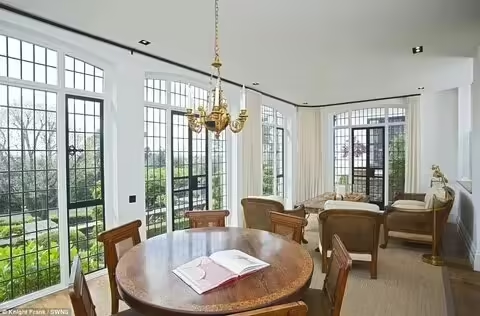
Top 10 Property Refurbishment Trends in 2025
Technology, customer tastes, and housing market changes drive property refurbishment. As 2025 approaches, numerous changes will influence how homeowners and investors refurbish properties. These trends show that current renovations prioritise energy economy, convenience, and personalisation, from sustainable practices to smart technology integration. This blog covers the top 10 property refurbishment trends in 2025 to help you remain ahead.
Eco-friendly Renovations
As climate change and environmental sustainability concerns develop, 2025 property refurbishment trends will emphasise eco-friendly alternatives. Green building approaches are growing, including sustainable materials, energy-efficient appliances, and solar power. To decrease their carbon footprint and utility expenses, homeowners and investors will renovate houses with energy-saving features like double-glazed windows, smart thermostats, and solar panels.
Energy-saving government initiatives and incentives are also driving low-carbon housing demand. Bamboo flooring, recyclable steel, and natural stone will be used in property refurbishments to reduce their environmental impact.
Automation and Smart Home Integration
Smart house improvement technology has been developing recently, but by 2025, it will be ubiquitous in building refurbishments. Smart home systems improve security, energy efficiency, and convenience, making them popular with homeowners. Innovative technology will influence property refurbishments, from voice-activated lighting and heating to security cameras and automatic window blinds.
In 2025, expect increasingly powerful automation systems that control all house operations from one app. Smart thermostats will let homeowners control temperatures remotely, and AI-powered devices will anticipate demands like daytime illumination adjustments. These systems will improve comfort and energy efficiency, making homes more sustainable and affordable.
Multipurpose, Open-concept Spaces
Open-concept living spaces and multi-functional rooms are in demand as lifestyles change, especially with remote employment. Homeowners want adaptable areas for business, pleasure, and family activities. New property refurbishment trends will emphasise open, airy layouts for many activities.
Walls will be removed and walls minimised to provide large home offices, gym spaces, and entertainment zones. These renovations will also feature multi-functional furniture for convenient space alterations. A dining table can be a work desk, and a sofa can be a guest bed. This trend reflects home design’s growing emphasis on personalisation and utility.
Biophilic Indoor-Outdoor Living
Biophilic design incorporates nature into buildings and is popular in home renovations. By 2025, more households will blend interiors with nature by bringing the outdoors in. Large windows that bring in natural light, indoor plants, and natural materials like wood and stone reflect this trend.
Additionally, indoor-outdoor living is anticipated to rise. With bi-folding doors, expansive decks, and garden spaces that extend the home, homeowners will increasingly blend interior and outdoor living spaces. These changes reflect the demand for sustainable, soothing, well-being-focused environments.
Renovating for Aging in Place
As the population ages, more homeowners are renovating their homes to live longer. This movement, known as “ageing in place,” makes homes safer, more accessible, and more comfortable for seniors. 2025 property refurbishments will feature grab bars, wheelchair ramps, wider entrances, walk-in showers, and better lighting to prevent accidents.
In addition to physical modifications, technology will be crucial to ageing-in-place refurbishments. Fall detectors, medication reminders, and voice-activated systems will be added to the home for convenience and safety. The need for senior-friendly houses will drive property refurbishments that prioritise accessibility and long-term liveability.
Vintage & Retro Design
Vintage and retro design will return to property refurbishments in 2025. Retro styles, including mid-century modern, Art Deco, and Victorian, are returning to homes. This trend lets homeowners add personality and charm to their renovated homes with classic components.
Vintage furniture, patterned wallpapers, and retro colour palettes will appeal to living rooms, kitchens, and bathrooms. These components will be mixed with modern features for a unique and personalised look. As retro design becomes more popular, homeowners will use reclaimed wood, metal finishes, and retro tiles.
Eco-friendly landscaping and Gardens
Sustainable landscaping is another 2025 property refurbishment trend. Homeowners will increasingly want sustainable outdoor spaces that sustain local ecosystems and require less water and care. Garden renovations will include drought-resistant plants, native species, and permeable paving.
In addition to environmental considerations, homeowners will create helpful outdoor spaces that extend their living rooms. Outdoor kitchens, fire pits, and seating will be added to the property for relaxation and enjoyment. Urban gardens, edible plants, and green roofs will grow as people seek more sustainable outdoor spaces.
Premium Home Improvements and Materials
As the real estate market becomes more competitive, homeowners invest in luxury renovations to improve their homes’ appearance and value. Marble worktops, custom cabinetry, and designer fixtures will be more common in refurbishments in 2025. Buyers and renters seeking sophisticated houses will love these luxurious features.
Owners will also create lavish, spa-like baths and kitchens for maximum comfort and delight. Luxury renovations will feature waterfall showers, freestanding bathtubs, and high-end appliances for exclusivity and comfort.
Upcycling and Repurposing Materials
Upcycling and repurposing will be important in 2025 property refurbishments due to the environmental impact of new materials and waste. Homeowners will increasingly use reused wood, old tiles, and salvaged furniture instead of mass-produced ones.
With this trend, renovated houses gain character and save waste. Old wooden beams can provide a rustic look, and salvaged tiles can make distinctive backsplashes. Upcycling is a cheap method of updating a home without sacrificing design or quality.
Health and Wellness-Focused Refurbishments
Property refurbishments in 2025 will emphasise physical and mental wellness, as health and well-being remain top concerns. This involves adding air purifiers, circadian lighting, and noise-reducing materials to the indoor environment.
More homeowners will add home gyms, meditation rooms, and other wellness areas. Biophilic design elements like plants and natural materials will promote calm and awareness in these places. Ergonomics will also be prioritised, with furniture and layouts built for comfort and wellness.
Conclusion
Property refurbishments will emphasise sustainability, technology, personalisation, and wellness. Staying ahead of these top 10 property refurbishment trends helps homeowners and investors keep their properties competitive, practical, and contemporary. Innovative technology, ecological practices, and flexible living spaces will shape property rehabilitation, making homes more pleasant, efficient, and environmentally friendly. Working with expert property refurbishment teams makes achieving your goals and maximising your property’s worth easy. Tauras Construction, London’s leading property refurbishment company, guarantees timely and efficient services that provide peace of mind.


